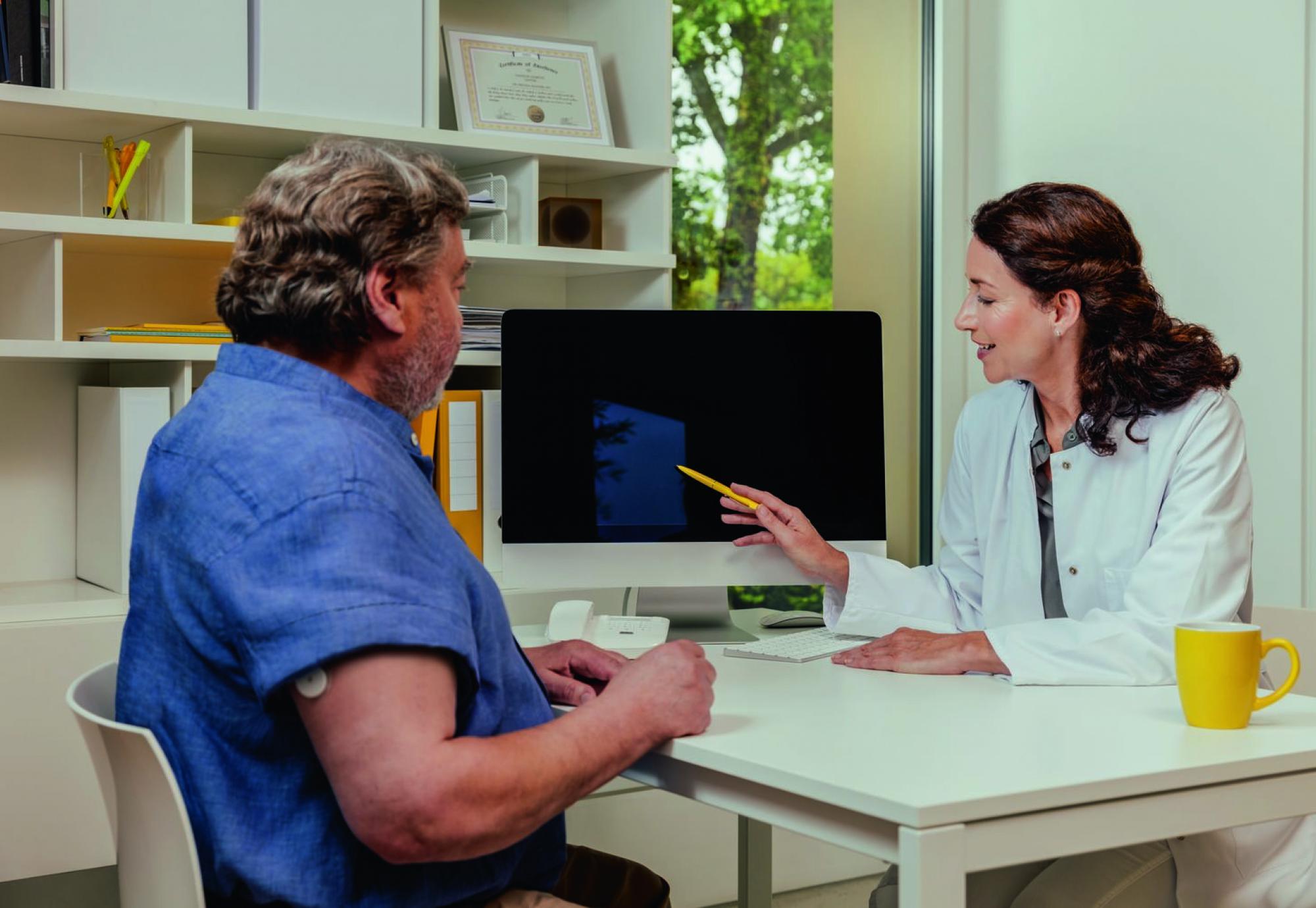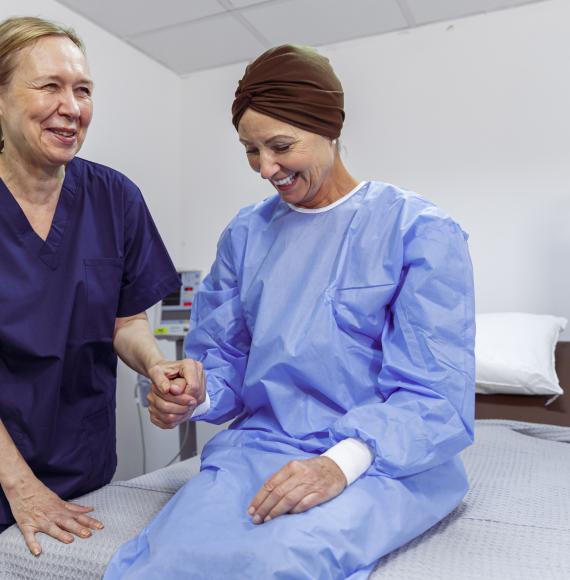In March 2022, NICE expanded its eligibility criteria for flash glucose monitoring (flash) to include those with type 2 diabetes who use insulin with certain parameters[1]. As a clinical lead in the management of diabetes, I believe this presents a real opportunity for our health system but we must ensure access to this technology is granted for all in our communities who could benefit.
Flash glucose monitoring allows people to check their glucose levels without having to draw blood through a lancet. A small biowearable sensor worn on the back of the upper arm reads glucose levels in the interstitial fluid (the fluid that surrounds the cells) and sends it to reading device (compatible smartphone or reader)[2] where alarms can be set to alert patients when glucose levels become too high or too low[3].
Today, more than 4.9 million people in the UK have diabetes, and Diabetes UK predicts this figure will rise to 5.5 million people by 2030[4]. Currently, the NHS spends £10 billion on diabetes-related care, which is around a tenth of its entire annual budget[5].
Recent research by the University of Manchester has shown that flash helps people with type 1 diabetes to lower their glucose levels, reduce their risk of serious short and long-term diabetes complications, and improves quality of life. Moreover, while finger-pricking was cheaper in the short-term, the research suggested those who used flash were more likely to stay healthier for longer, making it a more cost-effective long-term option for the NHS[6].
The expansion of access in the recently updated NICE guidelines is welcome news for eligible people living with type 2 who use insulin with certain parameters1. Real-world studies have shown that use of flash monitoring technology, such as Abbott’s FreeStyle Libre 2 system, is associated with a reduced risk of developing complications related to diabetes, such as cardiovascular disease, for people living with type 1 as well as those with type 2 diabetes[7]. This means better health outcomes, generally, across this significant population.
While on a national level access to and uptake of flash technology looks good, a closer look reveals regional health disparities and inequalities. Bradford in West Yorkshire, is a prime example.
Bradford has a highly diverse, multi-ethnic population, with the highest Asian population in the West Yorkshire and Harrogate region, and a 30% non-European population overall[8]. It is the 13th most deprived local authority in England[9] and has the youngest population in England – with 30% under the age of 18[10]. Importantly, in terms of health, Bradford also has the highest prevalence of diabetes in the country[11] and has increasing rates of young adults being diagnosed with type 2 diabetes[12]. This unique population therefore presents various challenges when it to comes to accessing technology and reducing health inequalities.
In 2021, flash uptake in Bradford was seemingly on par with the national average13. However, when the data is broken down into ethnicity and socio-economic status, two polarised realities come to the fore.
I tend to explain Bradford as a donut. The centre is hollow where there is maximum deprivation, the highest ethnic minority rates, and the highest diabetes prevalence. This is where we see lower flash uptake, in areas such as Manningham, where uptake is as low as 30%[13].
Around the donut, both the level of deprivation and the prevalence of diabetes starts to reduce. These areas tend to have a higher uptake of flash, at around 70% within the most affluent areas on the outskirts, such as Skipton and Ilkley13.
From this, a dichotomy can be seen within the population. For both communities, pathways of access are essentially the same; the same hospitals are delivering the care, and the commissioning statements across West Yorkshire and Harrogate are also the same.
So why is there such significant variance? Many factors contribute, including levels of cultural difference or engagement with healthcare providers in the two communities. To address challenges like these, a proactive, data-driven approach should be taken to reduce the inequalities and get diabetes technology to those who will benefit the most.
However, a grassroots and community view is also needed to ensure accessibility is considered in context. In my experience, for example, people from minority communities are often the least likely to proactively ask for a specific device or treatment, even when they could be a great candidate.
Therefore, it can be helpful to use data to drive decisions. A way to do this is to review the population to see who might benefit from flash, assessing them against certain criteria and risk stratifying the population into a “Red / Amber / Green” traffic light system.
Criteria considerations could include where the uptake of flash glucose monitoring is historically low; identifying how many patients would benefit; areas with the greatest need; and indices of multiple deprivation or percentages of higher risk non-European communities across primary care networks. This approach will allow you to allocate resource fairly, according to need.
In Bradford, we’ve seen targeted traditional communication approaches work better in some communities. One example can be taken from an instance during the pandemic, when a lot of in-person diabetes care was halted. We still wanted to focus on diabetes prevention, particularly in areas of health inequalities. Where, previously we used an umbrella approach, with the same messaging released everywhere, instead we focused on practices and patients from densely populated areas and responded through direct mailers and leaflets about diabetes prevention. As a result, we saw a surge in referral uptake for people from these communities, but more importantly, an uptake in their attendance at diabetes prevention initiatives too.
Ultimately, getting the recommended technology into the right hands will help support the NHS to make the greatest impact in the shortest time – so continuing to make the case for prioritising access to improve lives is essential.
There are many ‘Bradfords’ across the UK. For us, a community-minded approach has allowed us to spread the resource available to reduce the risk of future complications and support a better quality of life for those that need it the most.
From what I have seen, the NHS and commissioners understand that flash technology can be beneficial and has a positive effect on health outcomes – no one debates the evidence – but there can be hesitancy around cost. When system health budgets are restrained, it can be tempting to have a short-term view on upfront cost, versus long-term patient outcomes, potentially leading to slow adoption of a technology that can significantly help to improve lives across the UK.
Dr Waqas Tahir is Clinical Diabetes Lead, West Yorkshire and Harrogate Health and Care Partnership and Bradford District and Craven System Programme
Dr Tahir received a fee from Abbott to write this article. However, the views expressed are his own and not necessarily those of Abbott.
Healthcare professionals can learn more about the FreeStyle Libre 2 Flash glucose monitoring system here: https://freestylediabetes.co.uk/health-care-professionals
References
- NICE guideline (NG28) Published: 02 December 2015 Last updated: 29 June 2022; Type 2 diabetes in adults. https://www.nice.org.uk/guidance/ng28 Last accessed January 2023.
- The FreeStyle LibreLink app is only compatible with certain mobile devices and operating systems. Please check the website for more information about device compatibility before using the app. Use of FreeStyle LibreLink requires registration with LibreView.
- Patients choose which device they want to receive alarms: FreeStyle Libre 2 reader or FreeStyle LibreLink app. They must start their FreeStyle Libre 2 sensor with that selected device. Once the patient scans their FreeStyle Libre 2 sensor with that device, they can receive alarms only on that device.
- Diabetes UK (4 May 2021), Diabetes diagnoses double in the last 15 years , available at: https://www.diabetes.org.uk/about_us/news/diabetes-diagnoses-doubled-prevalence-2021 Last accessed January 2023.
- NHS England (28 March 2022), NHS Prevention Programme cuts chances of Type 2 diabetes for thousands, available at: https://www.england.nhs.uk/2022/03/nhs-prevention-programme-cuts-chances-of-type-2-diabetes-for-thousands/#:%7E:text=Evidence%20has%20shown%20that%20the,effective%20in%20the%20long%2Dterm Last accessed January 2023.
- The University of Manchester (30 March 2022), New study reveals positive impacts of Flash blood glucose monitoring on blood sugar and quality of life, available at: https://www.manchester.ac.uk/discover/news/ Last accessed January 2023.
- Evans M et al, Diabetes Ther 13, 1175–1185 (2022) https://link.springer.com/article/10.1007/s13300-022-01253-9 Last accessed January 2023.
- West Yorkshire and Harrogate Health and Care Partnership (2020). Tackling health inequalities for Black, Asian and minority ethnic minorities and colleagues. Accessible at: https://www.wypartnership.co.uk/application/files/7116/0284/2929/bame-review-report.pdf Last access January 2023.
- City of Bradford Metropolitan District Council (4 October 2019). Indices of Deprivation. Available at https://ubd.bradford.gov.uk/media/1534/indices-of-deprivation-2019-intelligence-bulletin.pdf Last accessed January 2023
- City of Bradford Metropolitan District Council. Population. Available at https://www.bradford.gov.uk/open-data/our-datasets/population/#:~:text=26.3%25%20of%20the%20District's%20population,Council%20and%20Luton%20Borough%20Council Last accessed January 2023.
- Diabetes UK (12 August 2021). Bradford district and craven beating diabetes through ground-breaking alliance. Accessible at https://www.diabetes.org.uk/about_us/news/bradford-district-and-craven-beating-diabetes-through-ground-breaking-alliance#:~:text=Bradford%20District%20and%20Craven%20has,living%20with%20diabetes%20on%20average. Last accessed January 2023.
- Bradford Teaching Hospitals NHS Foundation Trust (18 December 2019). Bradford ‘must act now’ to stop more children developing type 2 diabetes. Available at https://www.bradfordhospitals.nhs.uk/bradford-must-act-now-to-stop-more-children-developing-type-2-diabetes/ Last accessed January 2023.
- Abbott Diabetes Care. Data on file.



















